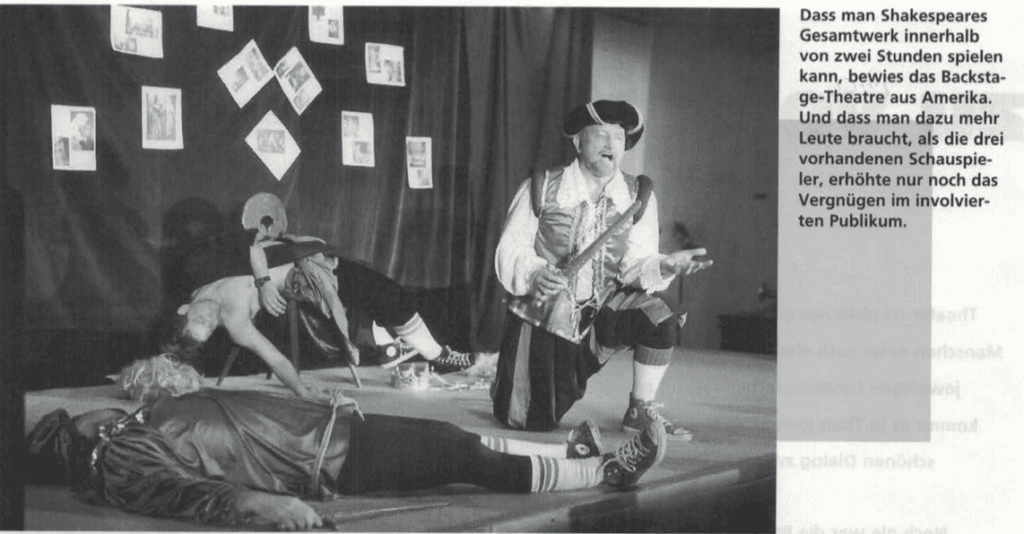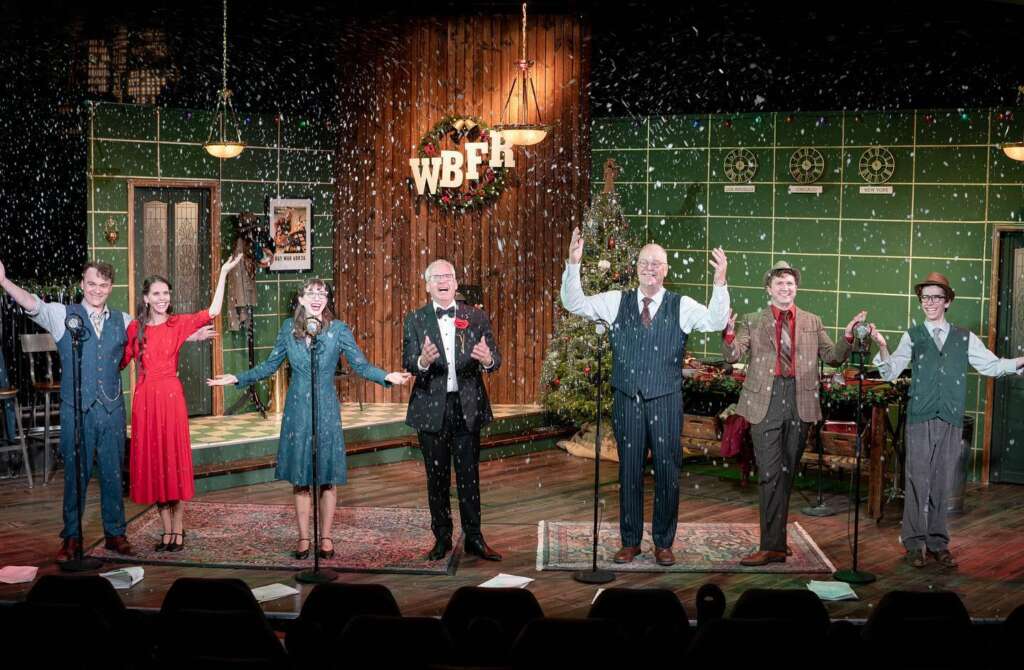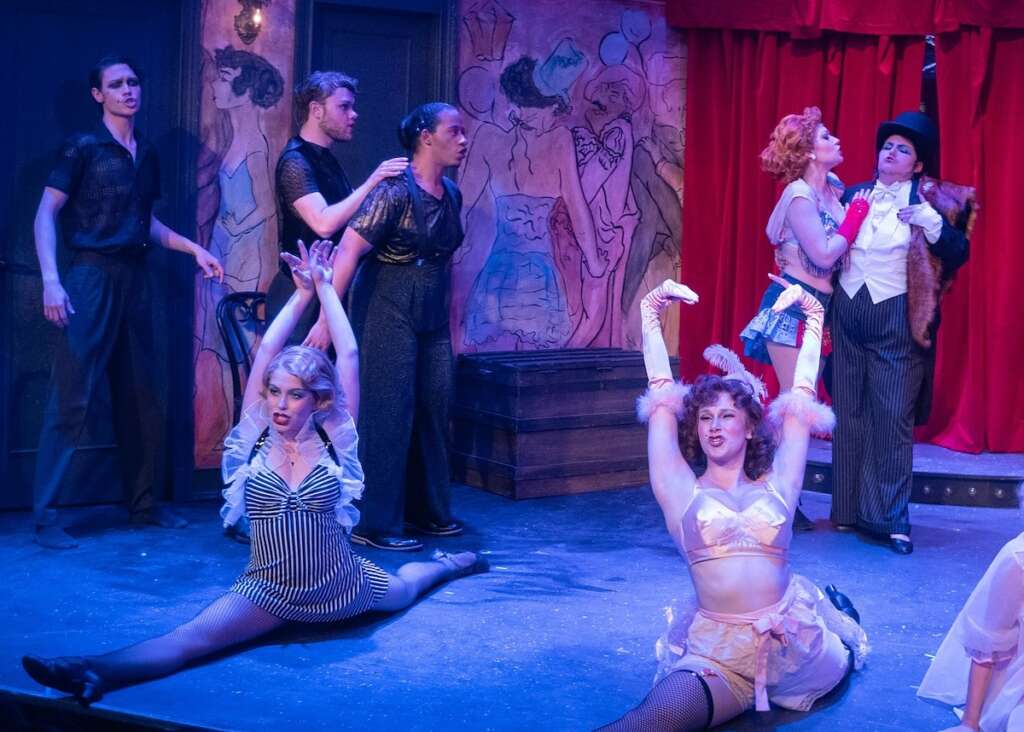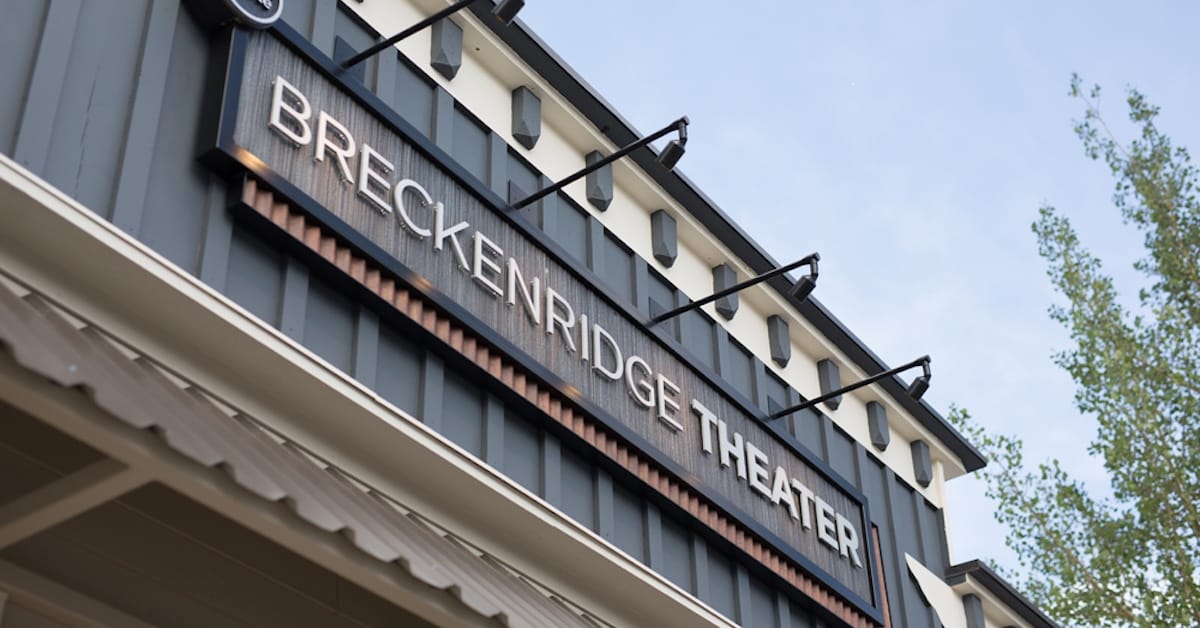The Western Slope’s oldest year-round theatre company heads into its sixth decade healthy and hopeful
Like many a small theatre, the Breckenridge Backstage Theatre has seen its share of ups and downs. From the pandemic everyone suffered through to multiple moves, artistic director shakeups and depleted funds, the Backstage has survived it all to get to 2024 and its 50th season.
That milestone means the Backstage is easily the oldest year-round theatre company on the Western Slope and one of the oldest in all of Colorado.
It was back in 1974 that Shirley Martin had the idea to start a theatre company in the ski town at 9,600 feet. She named it “Rockpile Productions” — a nod to the enormous piles of rocks that lined the Blue River around town leftover from the dredge-mining days. Like most startup theatres, there was no dedicated space, so the first shows were staged in a local watering hole — Singin’ Sadie’s Saloon.
That first production of the melodrama Poor Pitiful Pearl led to hundreds more productions up until this summer’s Cabaret. The theatre has made its home in more than half a dozen places before settling into its seeming forever home at the town-owned Breckenridge Theatre in 2002.
The early years
The “Rockpile” name soon gave way to “Backstage Theatre,” and Martin enlisted one of the actors from that first show, Allyn Mosher, to help manage the theatre. Mosher and his wife, Joyce still live in Breckenridge, and he recorded some remembrances on video for this summer’s anniversary gala held a few weeks ago.
“There was an ad in the paper for auditions for a theatre company,” Mosher said. “And I did the show and the next thing I knew, I was running (the theatre). It’s funny how that happens, right?”
Mosher points out that the Backstage became the first active nonprofit in Summit County in 1976 and, no surprise for a party town like Breck, holder of the first arts liquor license in Colorado in 1979. With Joyce’s help, he ran the theatre in those early years as it moved from the saloon to the (long-gone) Breckenridge Inn to a 74-seat space in the Sterling Building.
In 1980, the owner of a new condo development, The Village at Breckenridge, offered the Backstage a space on the ground level. Mosher got to work and led a team that created a legit, 98-seat space with two dressing rooms, a lobby, front desk and a light booth.
The theatre’s website calls the next two decades “the golden years,” with the Moshers overseeing a growing talent pool, more and diverse shows and the introduction of a children’s program.
The Moores
Among the talent pool was a young couple who’d moved to Breckenridge in 1978. Unlike some of the local actors, Bob and Wendy Moore already had a good deal of theatrical experience working at dinner theatres in Colorado and on Mississippi showboats. They’d met in Colorado in 1971 and were eager to move back, so, as Bob recalls, the first one to get a job would determine where they’d live next. When the Summit County School District offered Wendy a job as an English and drama teacher, fate penned the next chapter at the Backstage.
Bob’s first show was a 1978 production of The Fantasticks, and after Wendy got settled in at work, she also became active. (With some exceptions, Wendy stuck to the director’s chair while Bob preferred to be onstage.) In 1990, the Moshers handed the reins over to the Moores, and the next eight years would see a significant period of growth as Wendy, in the artistic director position, looked to raise the theatre’s profile and expand the types of shows it did.
Meanwhile, in true community-theatre style, Bob not only acted but designed and built just about every set at the theatre from ’78 to ’98. (After landing in Breckenridge, Bob built the family’s home by himself, and his day job was running a local hardware/lumber store. “Handy” is putting it lightly when it comes to describing this man.)
I caught up with Bob by phone in early August in Brooklyn, NY — the latest stop on the solo cross-country motorcycle ride he’s been on this summer. (Wendy died in October, 2022.)
“When Wendy was appointed artistic director, the whole vibe was to create quality community theatre, and we tried to do shows that weren’t schlock,” he said. “Wendy picked shows that put butts in seats to appeal to general audiences while also choosing shows that gave actors a chance to develop their skills.”
He noted that, like all small theatres, it was always all hands on deck for all involved. For he and Wendy, it meant juggling busy jobs along with raising their two daughters, Mandy and Missy.
“The Backstage was a huge part of our lives,” he said. “The reason we loved it was it was a small enough venue we could keep our hands wrapped around it and choose shows we wanted to do, while also being a good vehicle for others we knew. Plus, I got to do a bunch of shows with Missy — how cool is that?”
(Bob now lives in Carbondale, where Missy Moore is the artistic director at Thunder River Theatre Company. Mandy is a world-famous choreographer based in LA with credits including La La Land and Taylor Swift’s “Eras” tour.)

In July of 1998, the Backstage brought its production of ‘The Complete Works of William Shakespeare (abridged)’ to an international theatre festival in Thun, Switzerland. The show was performed in a 12th century castle. Pictured left to right are Alex Miller, John Whitfield and Bob Moore.
Backstage at the Riverwalk and CCTC
In addition to expanding the types of shows the theatre did, under Wendy the Backstage also launched some large-scale musicals in the Breckenridge Riverwalk Center. (Peter Pan, The Music Man and Fiddler on the Roof, where Bob realized a dream of playing Tevye.) The theatre also got involved with the Colorado Community Theatre Coalition for networking and to build the theatre’s reputation in the state.
CCTC is a part of the American Association of Community Theatre (AACT), and every other year the state festival has competitions. (This year’s was just held in Evergreen a few weeks ago.) The Backstage started competing, bringing shows to festivals in Vail, Steamboat, Aspen and others during the 1990s. (A role as the judge in a production of Inherit the Wind marked the first of many shows I was in with Bob.)
After winning Best Play at the state festival in the mid-’90s, the theatre brought its production of JB to the regional festival in Twin Falls, ID and then to the national festival in Michigan. From there, they got an invitation to attend an international festival in Thun, Switzerland. (Ask me sometime about the night we spent in a Swiss bomb shelter.)
The next phase
After Bob and Wendy moved to Glenwood Springs in 1998, the Backstage entered a challenging period — with the most significant being the loss of its space at The Village at Breckenridge in 2001. Artistic Director Jeremy Cole kept programming going at a variety of other spaces like restaurants and bars around Summit County.
But then the stars aligned and the theatre ended up in a space occupied by one of the county’s most notorious dive bars: Shamus O’Toole’s Roadhouse Saloon.
Shamus was a real guy, a biker with a ZZ Top beard and a hearty laugh who ran his saloon with, shall we say, somewhat relaxed standards. If you fell off your stool, they didn’t kick you out: They propped you up and got you another drink. But when Shamus was done with it all, the Town of Breckenridge bought the building and decided to turn it into a theatre — with the Backstage as the in-residence company.
There was a lot of work to do to turn the old roadhouse into a theatre, and it helped that Breckenridge is one of the wealthiest small towns in the country. (Its 2024 budget is $132 million.) The multi-year renovation included an expansion to provide dressing rooms and storage spaces, and another big upgrade worth $2.55 million took place in 2015. The theatre was also renamed the Breckenridge Backstage Theatre in 2012.

Chris Willard, right, with Skip Wee in a production of ‘The Mystery of Irma Vep.’ Willard was the BBT’s artistic director from 2005 to 2018. | Photo: Mark Fox/Summit Daily
Another milestone was the arrival of Christopher Willard, who was to become the BBT’s longest-serving artistic director from 2005 to 2018. A consummate theatre pro capable of acting, directing, writing, casting, picking shows, running the facility and somehow making ends meet, Willard was perhaps the ideal AD for a theatre in Breckenridge.
Although his tenure sometimes veered into controlled chaos, Willard seemed to instantly grok the Summit County vibe and had his finger on the pulse of how to address the challenge of any resort-town theatre: filling seats while appealing to tourists and locals alike. And while he ultimate left the theatre under less than ideal circumstances (another weird chapter in the Trump saga), he agreed to answer a few questions I sent him via email.
Read John Moore’s story about Willard’s departure in the DCPA NewsCenter.
Upon inheriting a somewhat adrift Backstage in 2005, Willard said he was determined to help the theatre refind its footing.
“The first year was hand-to-mouth with budgets razor-thin and lots of focus on ‘end of month,’” he said. “But if you could keep your cool and drive forward through the noise, it was a thrilling ride when you made all the numbers work. Which we did. My overarching goal was getting butts in seats.”
When the dust started to settle, Willard said he could focus on financial and artistic growth.
“We remade the brand and clawed back some of the donor base that had fled during a period when the theatre was rudderless,” he said. “We grew budgets, expanded staff, hired an executive director and eventually expanded the physical theatre itself and modernized. We had a blast doing it all.”
And, he said, he got to know the audience.
“We embraced the rough-and-tumble vibe of the town with shows that reflected that essence. We created new work designed specifically for actors in the community and invested in youth programming.”
Willard particularly loved working with kids and under his leadership created the Backstage Children’s Theatre Program. But he also loved edgy stuff, like Cannibal, The Musical — a stage version of South Park co-creator Trey Parker’s college film of the same name — and The Agony and Ecstasy of Steve Jobs.
“I’ll always prioritize not the shows that had sold-out houses, but the ones that had the most impact on the audiences and artists involved,” he said. “I’m most proud of shows that grew us as an organization — like musicals thought impossible to stage in a 90-seat house, or tiny two-handers that absolutely slayed, or categorically insane what-did-I-just-watch fare that could only happen at BBT. There’s nothing more fulfilling for me.”

2019’s ‘Taming of the Shrew’ | Photo Breckenridge Backstage Theatre
The new guard
After Willard’s departure in July of 2018, the Backstage again entered a stage of uncertainty. That October, Nathan Autrey became the theatre’s new artistic director. Our reviewer Shauna Farnell gave his production of Boeing Boing a strong review in March of 2019 while I really enjoyed the production of Taming of the Shrew. But just around the corner was the pandemic, and like every other theatre in the early spring of 2020, the Backstage shut its doors.
Autrey would not return, leaving in the fall.
In July of 2021, the Backstage opened back up with one of its most successful shows from the 1990s (and the one that went to Switzerland) — The Complete Works of William Shakespeare (abridged). Branden Smith had recently joined as the creative producer, and later that year their production of It’s a Wonderful Life: A Live Radio Play snagged six Henry Awards from the Colorado Theatre Guild.

The 2021 production of ‘It’s a Wonderful Life’ garnered the theatre six Henry awards. | Photo: Breckenridge Backstage Theatre
The following year, Jacqueline Stone joined as producing artistic director, and together she and Smith are enthusiastically kicking off the theatre’s sixth decade. At the heart of their partnership is a process for picking shows that sounds just a tad nerdy.
“It’s a really collaborative process between Branden and myself,” Stone said. “We have a pretty elaborate spreadsheets system, and we know that each slot in the season has a different job that we need it to do. Something will rise to the top, whether that’s because there’s relevancy to what might be happening in the world at that moment — like Cabaret this summer — or the timing felt right in terms of messaging and what it was saying.”
Seasonality, Smith said, is also always top of mind.
“It’s very specific to the times of year,” he said. “We have the most people visiting in the month of March, but they’re skiing and they tend to not come to the theater that time of year. We still have a lot of folks that are here in the summer, and they really show up.”
The shoulder seasons can be tricky, even as the growing tourism base in the county continues to shrink them. Smith said the theatre has had a lot of success in October with its annual Haunting of Breckenridge Theatre production. But he echoes Stone in how they look at different “buckets” of show types and how they can slot into each time of year.
“And we have to look at factors like what sort of housing can we acquire for that time of year and how much it’ll cost,” he said. “And as much as we hope to foster talent in the community, there’s always specific needs where we’re flying folks in.”
While appealing to tourists with more well-known titles is always a major consideration, Stone said the local community is up for more.
“With the locals, there’s an appetite to see some things that are really challenging,” she said. “They’re game for most things, I think, once the trust is established with the theatre.”

The theatre’s most recent production was this summer’s ‘Cabaret.’ | Photo: Branden Smith
A community asset
While it started out as very much a community theatre that cast locals exclusively, the Backstage has branched out to hire cast and crew from the Front Range and beyond — including from Stone’s old haunts in the Chicago theatre community. The bottom line, Smith said, is doing great theatre.
“Our main goal, of course, is quality and consistency,” he said. “So, when we have the choice between somebody who is local and at the same level (as a pro), we will take the local every time.”
It’s something Mosher and Moore both called out as well.
“I would like to see more community involvement,” Mosher said. “I think the Backstage, and it’s not a criticism, but it’s gone very much in a professional direction. But the concept of a theatre that really draws the community in not only as audience, but also as participants is really important for that kind of artistic communal organization.”
Asked for his advice on where the theatre goes next, Moore said remembering the past is key to the future.
“I’d like to see them honor the history of the theatre and continue to make it grow, make it better and keep it part of the community,” he said. “Don’t be afraid to take it someplace, but remember the history.”
He, for one, said he’s eager to see where the Backstage goes from here.
“Fifty years is a long time, and the theatre is still kicking because of its commitment to excellence and believing in the community,” he said. “A theatre like the Backstage is just such a positive for the community that gives people an artistic outlet while providing great entertainment to all the folks passing through.”
While the upcoming season hasn’t been announced in full yet, Stone said the Backstage will be doing a youth production of Finding Nemo, Every Brilliant Thing in the spring and Young Frankenstein next summer.
Alex Miller is editor and publisher of OnStage Colorado. He has a long background in journalism, including stints as the top editor at the Vail Daily, Summit Daily News, Summit County Journal, Vail Trail and others. He’s also been an actor, director, playwright, artistic director and theatre board member and has been covering theatre in Colorado since 1995.








Great article ~thanks Alex !